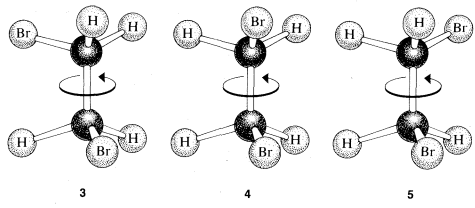
The Question of Rotational Isomers
 المؤلف:
John D. Roberts and Marjorie C. Caserio
المؤلف:
John D. Roberts and Marjorie C. Caserio
 المصدر:
Basic Principles of Organic Chemistry : LibreTexts project
المصدر:
Basic Principles of Organic Chemistry : LibreTexts project
 الجزء والصفحة:
........
الجزء والصفحة:
........
 21-12-2021
21-12-2021
 2471
2471
The Question of Rotational Isomers
The tetrahedral carbon does not solve all problems without additional postulates. For example, there are two different compounds known with the same formula C2H4Br2. These substances, which we call isomers, can be reasonably written as

However, ball-and-stick models suggest further possibilities for the second structure, for example 3, 4, and 5:

This is a problem apparently first clearly recognized by Paterno, in 1869. We call these rotational (or conformational) isomers, because one is converted to another by rotation of the halves of the molecule with respect to one another, with the C−C bond acting as an axle. If this is not clear, you should make a ball-and-stick model and see what rotation around the C−C bond does to the relationships between the atoms on the carbons.
The difficulty presented by these possibilities finally was circumvented by a brilliant suggestion 4, and 5, do not have separate stable existence, but are interconverted by rotation around the C−C bond so rapidly that they are indistinguishable from one another. Thus there is only one isomer corresponding to the different possible rotational angles and a total of only two isomers of formula C2H4Br2. As we shall see, the idea of free rotation required extensive modification some 50 years after it was first proposed, but it was an extremely important paradigm, which, as often happens, became so deeply rooted as to become essentially an article of faith for later organic chemists.
 الاكثر قراءة في مواضيع عامة في الكيمياء العضوية
الاكثر قراءة في مواضيع عامة في الكيمياء العضوية
 اخر الاخبار
اخر الاخبار
اخبار العتبة العباسية المقدسة


